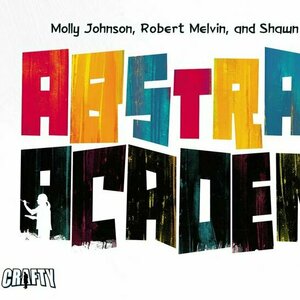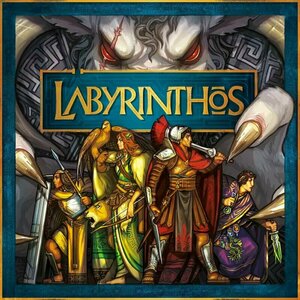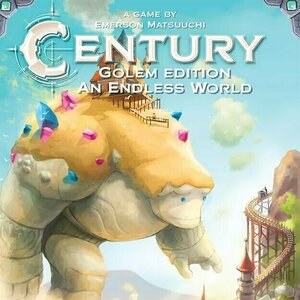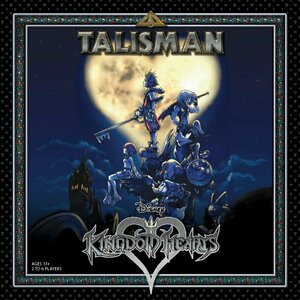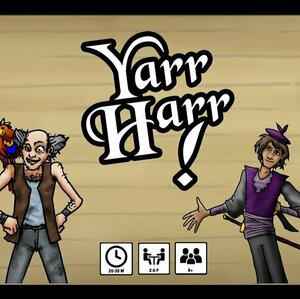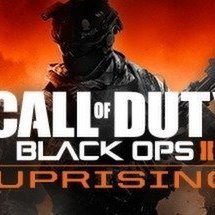
République
Games and Entertainment
App
In “Episode 5: Terminus," the fifth and final episode of the thrilling République saga, battle...

Designing Places for People and the Environment: Lessons from 55 Years as an Urban Planner and Shaping the Global Landscape Architectural Practice of the SWA Group
Andrea Hansen and Kalvin Platt
Book
Part autobiography, part firm history and part a look at the future of urban design, Designing...
Purple Phoenix Games (2266 KP) rated Abstract Academy in Tabletop Games
Feb 25, 2022
Abstract Academy is a card laying, hand management, pattern building game for two to four players. In it, players become art school students trying to impress their teachers. The only problem is that they must share a canvas, as the costs of school allow them very few luxuries. The player who can most effectively build masterpieces and satisfy all tested requirements over three rounds will ace the class and claim victory over the other starving artists.
DISCLAIMER 1: We were provided a copy of this game for the purposes of this review. This is a retail copy of the game, so what you see in these photos is exactly what would be received in your box. I do not intend to cover every single rule included in the rulebook, but will describe the overall game flow and major rule set so that our readers may get a sense of how the game plays. For more in depth rules, you may purchase a copy online or from your FLGS. -T
DISCLAIMER 2: My current temporary housing did not want me to have great lighting for photos in this review. Please try to ignore the yellow tint; I do not enjoy over-editing game photos.
To setup, shuffle each deck type and place the decks on the table. The rulebook does not specify where, so just throw them wherever. This is a game about art, so be creative. Each player draws a hand of three Canvas cards (with the whitish back and colors on the faces). The starting Teacher’s Pet player will then reveal cards according to the round from the respective decks, per the rules and provided reference cards. Each round will reveal different sets of Assignment and Professor cards. Players also draw one Inspiration card and the game is ready to begin! Paintbrushes at the ready!
Turns could not be simpler: Play a Canvas card, and then Draw a Canvas card. Both of these actions are self-explanatory, but let me expound on this a bit. Once the first Canvas card has been played by the current Teacher’s Pet, each subsequent card must be played orthogonally adjacent to another card on the table. To define the size of the entire project’s canvas, players will be confined to a 4 x 4 grid of cards. Once a column (the cards that would lead a path to the opponent) has been completed with four cards, the rows gain special rules. Firstly, the row closest to each player becomes the “Home Row.” Players may only play cards into their own Home Row, unless the only legal place to play a card is in the opponent’s Home Row. Secondly, the Home Row and the row above it is now consider the Scoring Zone, and will dictate which cards are able to be used to satisfy Inspiration, Professor, and Assignment requirements for VP. Therefore, until the 4 x 4 grid has been solidified, players are unaware which cards may end up in their Home Rows or Scoring Zones!
Victory Points are earned by scoring the special requirements of Inspiration, Professor, and Assignment cards once the entire 4 x 4 grid of Canvas cards is complete. Oftentimes players will need to compare scores to determine which player earns the points. For example, the Moret Professor card states that five VP are earned when the player controls the “most color areas with four or more quadrants.” Each Canvas card is divided into four quadrants, and quadrants are colored with one of the primary colors. A “color area” is simply a connected network of the same color within the player’s Scoring Zone. So, to satisfy Professor Moret, the player who controls the most amount of color areas that are four quadrants or larger.
Assignment cards come in Red, Blue, and Yellow, and pertain to those colors. For example, the red “Get to the Point!” Assignment requires the “most red areas with only one quadrant.” So the assignment is asking players to dapple their canvas with unconnected red quadrants.
In stark contrast, the Inspiration card requirements resemble shapes of quadrants, as opposed to colors or numbers of quadrants. Most of the shapes on these cards are reminiscent of Tetris-style shapes, where players will score their Inspiration cards by building the correct shape of connected quadrants of the same color within their Scoring Zone.
Once these cards are all scored for the round, the Teacher’s Pet sets up for the next round per the rulebook/reference cards. The subsequent rounds will require alternate decks to reveal cards, or choice of decks. When the third and final round has been scored, the points are tallied and the victor is crowned! With a construction paper and macaroni crown, most likely. They ARE starving artists, after all.
Components. This game is a double-card-deck box with 90+ cards and a rulebook. The cards are great quality, but the true hero here is, and appropriately so, the artwork. Every card is very stylish, the Professors are all nods to real artists (well, except maybe not the promo), and it has just a really great look overall. While being played, it just has an amazing table presence. I like that a lot.
I struggled with assigning a score to this one for a few reasons. First, I like so much about this game, and I dislike a few things. I very much enjoy having so many ways to score points each round, as it keeps my mind busy with trying to put the puzzle together. The monkey wrench, though, is that when you start a round, you play cards that may not even end up in your Scoring Zone. As your hand is always three cards, it is difficult to really plan too far in advance to create a perfect Scoring Zone. Is that a bad thing? Maybe, but I think it is also quite necessary to add a little chaos to this specific game. I will explain what I mean in a bit. Perhaps a few points docked for that.
Playing Canvas cards effectively is absolutely the crux of this game, because if a pattern or shape is being built to your benefit, your opponent can easily (and definitely accidentally) ruin your best laid plans with an ill-placed card to wonkify the grid. I think that is both delicious and very very frustrating. You know what? I will decide to give a few points back for this.
The ability for the Teacher’s Pet, a title that can be passed to the other player throughout the game, to choose which two of the three Assignment decks to reveal during Round 3 just adds to the replayability factor of Abstract Academy. True, there are only five cards in each Assignments deck, and there are mathematical or statistical formulae that can calculate the exact number of possible different unique games, the ever-changing grid of cards is what makes this nearly infinitely replayable. Okay, more points earned here.
I guess I judged too harshly, and my true rating is a little lower than perhaps this little game deserves. I absolutely know that I will be playing this a whole lot more – with gamers of all ages and weight preferences. It is easy to teach, keeps the brain engaged throughout, and forces players to step back and truly appreciate that which they have equally built together. I can completely foresee my score for Abstract Academy increasing with more and more plays, so please do not regard a 4 / 6 from Purple Phoenix Games as an absolute and inflexible score.
If you are a gamer who enjoys just a little chaos added to their careful planning, light and quick card games that pack more punch than expected, and some truly awesome table presence, then you most certainly need to grab a copy of Abstract Academy. I am soon to be culling my collection and curating it to only include games I thoroughly enjoy. I have a feeling Abstract Academy is going to make the cut. It checks off so many boxes for me and how I game, and I cannot wait to introduce my kiddos to it when they can grasp the concepts.
Purple Phoenix Games (2266 KP) rated Labyrinthos in Tabletop Games
Feb 10, 2021
Disclaimer: I do not intend to rehash the entire rulebook in this review, but rather provide an overview of the rules and game flow. -L
Labyrinthos is a game of action and adventure in which players are exploring the famed Labyrinth of Daedalus, searching for the 4 secret keys that will let them escape! All this while avoiding traps, their competitors, and the deadly Minotaur who seemingly lurks around every corner. To setup for a game, create the Labyrinth as described in the rules – in the end it will be a 7×7 tile grid. Each player receives a Player Board, Standee, 4 Desperation cards, 7 Action tokens (3 Hand tokens and 4 Feet tokens for the first turn). The remaining Desperation cards and tokens are placed to the side of the play area, along with the Key tokens. Select a starting player, and the game is ready to begin!
Over a series of rounds, players will take turns performing various actions, exploring the Labyrinth, searching for Keys, and avoiding the Minotaur. On your turn, you will be spending Action tokens to perform various actions, like: Move (to an adjacent tile), Explore (flip over an adjacent face-down tile and move to it), Discover Key (gain the corresponding Key token to your Player board), Desperate Action (play a Desperation card), and a handful of other actions. Each action has a token cost associated with it, and you must pay it in order to perform the action. Each different Player Board also has a unique Special Ability that is active during the game. Once you have taken as many actions as you can/want to take, you will return any unused Action tokens to the supply, and then choose a combination of 7 new Action tokens to be used on your next turn. Then, you will refresh your hand – drawing or discarding Desperation cards so your hand limit is 4 minus the number of Key tokens you possess.
The final step of your turn is to roll the Minotaur die and resolve his movement/actions. The movement of the Minotaur is similar to the movement rules of players, and some results on the Minotaur die activate special abilities. If the Minotaur ever enters a tile occupied by a player, he immediately Attacks! The controlling player rolls the Blood die, and the attacked hero gains that number of Wounds to their Player Board. A Wound on your Player Board will cover one of your turn actions, prohibiting you from performing that action until you spend Action tokens to Heal. Certain tiles of the Maze have special symbols that will immediately affect the gameplay. For example, any time a player moves onto a Trap tile, they immediately take a Wound. When a player is on a Hide tile, they cannot be Attacked by the Minotaur. Play continues in this fashion, alternating turns, until a player has collected all 4 Key tokens and made their way back to the starting Door tile. That player has successfully escaped, and all others remain trapped in the Labyrinth!
I know that may seem like a lot, but the gameplay itself is actually pretty streamlined and intuitive. The action descriptions on the Player Boards are clear and concise, acting as a player reference sheet in a way. I appreciate the Player Boards SO much because it keeps me from having to continually refer to the rulebook for any action questions. The action options themselves are simple to understand and perform, but the strategy required for overall success is trickier to master. This truly is an exploration game – the 7×7 grid is created anew every game, and chances are you will never play with the same grid layout twice. The Key tiles could be anywhere, and you have to try to get to them before your opponents. The different tile symbols offer some risk/reward decisions. Do you risk turning over an undiscovered tile in hopes that it gets you across this gap? It could be a Trap! Or it could be a Secret Passage that allows you to move elsewhere. You’ll never know if you don’t try it!
I also really like the mechanic of the Minotaur in this game. At the end of your turn, you roll the Minotaur die and resolve it. That means the Minotaur is essentially controlled by all players. It becomes a sort of tug-of-war, if you will, as players try to get the Minotaur to attack opponents, while hopefully also staying out of his range for the next player’s turn. Another neat thing about Labyrinthos is that when you collect a Key token, it actually provides you with an action and is added to your Player Board, covering an existing action. Through the use of actions and Desperation cards, you could be able to move Keys around on your Player Board too. Maybe its initial placement doesn’t fit the situation anymore, and you need that covered power back! The opportunities to strategize with your actions are endless, and that keeps the gameplay engaging. One last cool thing I want to mention is the selection of new Action tokens at the end of each turn. Certain actions require Hand, Feet, or both types of tokens, and having the ability to choose the combination of those for yourself feels pretty powerful. It could also quickly backfire, if suddenly you find yourself needing Feet tokens, but you only have Hands left! It’s another layer to the strategy, and it helps up the excitement of play.
Components. The components of this game are great. The maze tiles are nice and sturdy, the symbolism clean and clear. The Desperation cards have some cool flavor text, and their actions are straightforward. All of the Standees, tokens, and dice are good quality that will hold up to lots of handling. All in all, great production quality!
I am extremely happy that I decided to back Labyrinthos on Kickstarter. For being a seemingly simple game of maze exploration and movement, there is definitely a lot more to it than meets the eye. Players have to manage resources and plan ahead for what they need in subsequent turns. Desperation cards can affect the gameplay, and can sometimes even be used during an opponent’s turn. The ability of Key tokens to cover existing abilities really makes players think about what their strategy is moving forward. All of these aspects put into one game make for a fun and immersive experience. Purple Phoenix Games gives it an a-maze-ing 10 / 12. Also, special shout-out to the all-female team behind this great game!! It is really cool to see how women are moving up in the gaming industry, and becoming prominent players across game design, art, production, and media content realms within this hobby. Kudos to you ladies! I am very much looking forward to supporting your games in the future!
Purple Phoenix Games (2266 KP) rated Century: Golem Edition - An Endless World in Tabletop Games
May 5, 2021
Disclaimer: This game comes with rules to incorporate any/all of the Century Golem games into one bigger game. In this review, I will only be discussing the stand-alone final game in the Century Golem trilogy. -L
Century: Golem Edition – An Endless World (referred to as just An Endless World for this review) is a game of set collection and worker placement in which players are trying to earn the most points by the end of the game. To setup the game, follow the instructions outlined in the rules, dependent upon your player count. Each player begins the game with 6 Trader meeples (or 7 in a 2-player game) in their supply, and a specified number/type of crystals. The game is now ready to begin!
On your turn, you will have 2 options: Work or Rest. To Work, you will first select a location square on the board. You may not choose a location where you already have Traders, or that has an Exploration tile. You will then place Traders from your supply onto the chosen location – the number of Traders required is printed on the location. If the location is unoccupied, simply place the required number of Traders. If the location is occupied by an opponent, you may place Traders there, but you must match the opponents Traders, plus an additional Trader, to take control of the location. Any opposing Traders ousted in this manner are returned to their players’ supply. Once you have placed Traders on a location, you can then perform the action listed on that location. Action options are: producing gems, upgrading gems, trading gems, or collecting Point cards/bonus tokens. If you cannot or do not want to use a location on your turn, you can Rest. To Rest, you will collect all of your Traders from the board and place them back into your supply.
Point cards can provide immediate, ongoing, or end-game benefits for players. Help cards allow you to place 1 fewer Trader than required on certain locations. Tool cards give players an additional gem of a specified color when they place Traders on corresponding locations. New Trader cards allow players to add either 1 or 2 more Traders to their supply, thus increasing their ability to play each ’round’ before needing to Rest. Finally, Exploration cards allow the player to select an Exploration token from the board. Any time an Exploration token is claimed, that location is now ‘uncovered’ and can be used for the remainder of the game. Bonus tokens grant end-game points based upon sets of icons collected, number of Traders in your supply, or simply straight-up points.
The game continues in this fashion, alternating turns, until a player has collected their 8th Point card. The current round is played out, and then points are counted. Points are earned through Point cards, bonus tiles, Exploration tiles, and any remaining gems in your supply. The player with the highest score wins!
One thing I really like about worker placement games is that the actual gameplay is pretty logical and straight-forward. Place your worker, perform action. And An Endless World is no exception to that. Of course, how you decide to play all comes down to your strategy, and again, An Endless World has tons of options for players. Maybe you want to just get 8 Point cards as quickly as possible and call it a day. Or perhaps you want to maximize your bonus tokens and eke out as many points from those as possible. Or maybe you even just want to keep your opponent(s) from achieving their goals. You can play this game so many different ways, and you can totally adapt and change strategy mid-game if you so choose. Each game feels unique and new, and I have yet to tire from this gameplay.
An Endless World is a worker placement game, but there is one factor that I find extremely unique for the mechanic. Usually, in worker placement games, once a worker has occupied a location, it remains there until the player chooses to recover their workers. An Endless World offers players the chance to oust opponents from locations, by placing the same number plus 1 additional worker. I just think this is super neat, because it means that you can’t just ‘block’ a location from everyone. If someone really wants that location, and they have the workers, they can get to that location. Also, along those lines, since ousting a player from a location means you have to match their workers plus an additional worker, you have to decide if you want to risk dedicating that many workers to a single location. You might reaaaaally want to perform that action, but for the cost of 4 Traders, is it worth it at this moment? Could those workers better be used on different locations and you just snatch your desired location on a future turn? All part of your strategy for the game, and definitely keeps all players engaged.
Let me touch on components for a minute. As with the other Century Golem games, An Endless World is extremely well-produced. The gems are the same quality, the cards are nice, thick, and clear to read, and the cardboard tokens are nice and sturdy. Plan B Games has hit the mark on this trilogy of games, and they truly are a pleasure to play. Obviously, the artwork and theme consistency throughout the Century Golem trilogy has been really satisfying, but that also carries over into the gameplay. All 3 games use much of the same iconography, so honestly learning An Endless World was super fast and easy for me. That uniformity is extremely user-friendly and is a huge plus for me.
So I guess you can see from my score and from reading this review that I am a huge fan of An Endless World. The final game of this trilogy is a home run for me, and I just keep thinking about what strategy I want to try in my next game. That in and of itself is an indication of a great game – thinking about it even when you’re not playing it! I have yet to try the variants that include the other 2 Century Golem games, and I am very much looking forward to integrating them all into one giant and (hopefully) awesome Century Golem saga. Purple Phoenix Games gives this one an expansive 16 / 18. Give it a shot, even if you haven’t played the other Century Golem games!
Purple Phoenix Games (2266 KP) rated Talisman: Kingdom Hearts in Tabletop Games
Dec 10, 2020
In Talisman Kingdom Hearts (which I will now call simply Talisman for this review) players will be taking on roles of Kingdom Hearts characters to traverse the world with the ultimate goal of reaching the Door to Darkness and sealing it forever. The player who seals the Door ends the game, but it does not necessarily mean they will win this semi-cooperative-but-mostly-competitive roll-and-move game.
DISCLAIMER: We were provided a copy of this game for the purposes of this review. This is a retail copy of the game, so what you see in these photos is exactly what would be received in your box. I do not intend to cover every single rule included in the rulebook, but will describe the overall game flow and major rule set so that our readers may get a sense of how the game plays. For more in depth rules, you may purchase a copy online or from your FLGS. -T
To setup, follow the instructions in the rulebook. Each player will either be dealt a character at random or may choose from the 11 characters in the box. The gigantic board goes wherever it will fit on the table, and the decks of cards are to be shuffled and stacked nearby. The Object cards will be separated by type and placed face-up near the face-up pile of Keyblade cards. Players will adjust their Stat Dials to match the starting stats printed on their character card and the game is ready to begin!
Talisman is a game played over a series of many very quick turns. Each turn is comprised of two phases: Movement and Encounters. During the Movement phase within the Outer and Middle Regions the active player will roll 1d6 and decide to move clockwise or counter-clockwise that many spaces around the board. Once within the Inner Region players will move one space at a time and no longer need to roll. Once a player lands on a space they will have Encounters while stopping.
Encounters on a space may involve several cards in play. Spaces on the board will have written instructions or merely iconography to instruct players what to do on each space. If drawing an Adventure Card from the deck, the active player may come across enemies to fight, followers to recruit, or even items to help in their journeys.
Combat is pretty slick and easy in the game: the player has a base Strength or Magic stat on their dials to which is added the result of a die roll. Compare this to the enemy’s matching base stat plus their roll. The larger result wins the combat. The player takes the enemy card as a trophy when they win, and loses a Health value when they lose and the enemy typically stays on the board space until defeated.
Play continues in this way (with a few more surprises along the way that I will have you play to discover on your own) of taking turns moving and encountering spaces until one player seals the Door to Darkness. Players are then awarded VP for various numbers of cards, where they end up on the board, stat differentials, and other means. The player with the most VP wins the game!
Components. This is a large box and comes with several different types of components. The first is a monstrously-sized game board that takes up a lot of space. That’s not at all bad, but it is certainly a busy board. There is so much information and artwork on the board, and also may have tokens set upon it to be linked to cards on the table. With over 200 cards in the box along with player character cards, stat dials, and 11 plastic minis you get a lot in the box for your money. I would say that all of the components are of excellent quality and I have no qualms with any of them aside from the very large and very busy main board.
I have some good and bad news here. First the bad. This plays somewhat similarly to a game I happen to have very lukewarm feelings for: Jim Henson’s Labyrinth. In both games players are rolling a die and deciding which direction to travel in order to have an encounter on the space. Combat is decided primarily by stats and die rolls with only the Fate tokens in Talisman to assist with a re-roll of one die. Combine that with the frustration of needing to land exactly on a space on the board in order to progress to the next Region inward and players may be volleying themselves back and forth trying to roll just the right number to hop into the Middle or Inner Regions.
That all said, I still do enjoy this game. Yes, I like it because of the art and the theme. I have always said that I prefer my games to have great art and a great theme before I start to care about mechanics and other attributes. This is a case in point. I love the look of the game, the table presence, the Kingdom Hearts IP, and I typically do not gravitate toward roll-and-move games. But, there is enough in Talisman that it keeps me interested in playing more and more. I will eventually be able to play with all of the different characters to experience their own unique special abilities and select a character with whom I most relate. I think I will enjoy that journey.
I can also play this game with my wife pretty readily, and that is a huge positive for me. I know that in time my children will be able to play this game without much arm-twisting as well as we are a huge Disney household. The rules are relatively light, and the rulebook does a great job of breaking everything down. That said, Purple Phoenix Games gives this one a hybridized and limit broken 9 / 12. If you love the Kingdom Hearts IP, or the Talisman games, or even games to introduce to newer players, then you need to take a look at Talisman Kingdom Hearts. I am still discovering things in the game that I hadn’t noticed on previous plays and that keeps me coming back for more. You won’t feel the brain burn here but you will have a great time having Chip ‘n Dale, Dumbo, and Tinkerbell following you along your adventure.
Purple Phoenix Games (2266 KP) rated Yarr Harr! in Tabletop Games
Jul 2, 2020
Disclaimer: We were provided a copy of Yarr Harr! for the purposes of this preview. The final components of the upcoming Kickstarter campaign might vary slightly from those pictured below. Also, our copy had some extra cards/content that will be available as Stretch Goals during the campaign. -L
Yarr Harr! is a competitive card game in which players are building up their individual pirate ships and trying to amass the most Doubloons by the end of the game. The gameplay itself is pretty simple, but actually winning takes more strategy than you might think. To setup the game, every player receives a Bow and Stern card for their Harbor (play area), and a starting hand with 5 cards. The remaining cards form the Draw deck for the game, and is placed in the center of the play area. On your turn, you will draw 2 cards from the Draw deck, and then play up to 3 cards. There are 2 different types of cards that can be played: Ship cards and Action cards. Ship cards, played between your own Bow and Stern cards, are used to build up your ship and score points at the end of the game. Action cards are used to sabotage opponents or to give yourself a buff. You may not play more than 2 Ship cards in one turn, and you may only have a maximum of 8 cards in your hand at the end of your turn. Play continues as such, until the end-game requirement has been met. That requirement depends on the number of players in the game, and tells you how many Ship cards must be in your own Harbor for the game to end. As soon as any 1 player achieves that number, the game ends. Players then tally up all of the Doubloon points on the Ship cards in their Harbor, subtracting any negative points from Action cards affecting their ship, and the player with the most Doubloons wins!
The thing that I like about Yarr Harr! the most is that it can be played with differing levels of strategy. The game comes with a number of Captain cards and Objective cards that are optional to use in play. To include Captain cards, each player receives 1 Captain card at the start of the game, which grants special abilities throughout the game, depending on the given Captain. To play with Objective cards, each player receives 3 Objective cards at the start of the game, and then selects 2 to keep for play. Objectives are kept secret from your opponents, and will earn you end-game Doubloons upon completing them. With these optional modes of play, you can really cater the strategic level to that of your current game group. You can play with younger gamers with no extra content, just the base game as described above. If you are looking to turn this into a possibly more difficult game, add in those Captain and Objective cards. Offering those optional elements is a huge plus because it makes Yarr Harr! accessible to more gamers. So that’s a big win to me.
The other thing that I really like about Yarr Harr! is that the gameplay is pretty light and fast. It is easy to teach, learn, and play, thus lending itself to lots of gaming situations. Need something quick to play before dinner is ready? Yarr Harr! Want to pick the pace back up after a long, brain-burning game at game night? Yarr Harr! It can fit in wherever you want, and because of that, I can see myself bringing it to the table often. The only warning I have for this game is that, since it is competitive, more sensitive gamers might not find it enjoyable. There are Action cards to be played to directly sabotage and inhibit your opponents, and sometimes that can feel like personal attacks against a player. To alleviate that, I recommend playing at higher player counts, so it doesn’t feel like players are ganging up on a single player. Just something to be aware of! Let’s talk components. This is a card game, and the quality of the cards we received was pretty good. They are nice and sturdy, and could hold up for many plays. The artwork is thematic, creative, colorful, and just enjoyable to look at overall.
All in all, I think Yarr Harr! is a fast and fun game for any type of gamer. The varying degrees of difficulty and strategy make it a versatile game, and I really appreciate that aspect. It is a competitive game, but it feels more light-hearted than cutthroat and that helps keep it enjoyable for all players. If you’re looking for something fun, yet strategic, and easy to play, look no further than Yarr Harr! The Kickstarter campaign begins on June 23rd, so be on the lookout for this awesome little card game!
Gareth von Kallenbach (980 KP) rated Call of Duty: Black Ops II - Uprising in Video Games
Jun 19, 2019
The pack offers for new maps as well as a new zombie mode called Mob of the Dead, which casts players as inmates at Alcatraz which is being overrun by the undead. Gameplay wise it is similar to pass on the modes in net weapons, power ups, ammunition, and access to other areas of the maps can be obtained through purchase using the in game currency accrued from dispatching the undead.
There is also a nice surprise to this that in addition to trying to locate and assemble parts to make your escape, the voice talents of Michael Madsen, Joe Pantoliano, Chazz Palminteri, and Ray Liotta, provide a very nice depth to the game as they helped bring an infusion of personality to the characters which really makes you care about their outcome.
There is an afterlife mode as well which is necessary for accessing certain areas and gathering components needed for survival. It is also very satisfying to shock some of the undead minions while in this gameplay mode. Players were one and make sure to avoid the new boss Brutus who gives out a solid amount of damage every time he appears.
The four maps are available for play in various modes such as Team Death Match and Mosh Pit but do not offer the number of online modes that are available for the standard version of the game.
Vertigo is set in a futuristic high-rise in India and requires gamers to be very careful about where they step if they wish to avoid plummeting several stories to their doom. With a circular outside platform and limited indoor areas the emphasis is on using cover as much as possible especially from the abundant cargo and air-conditioning units that litter the map. I found this to be the least satisfying for my style of play as not being able to run, and constantly being at the mercy of snipers did make it very frustrating for me.
Encore is set in London at a music festival and offers a nice mix of options for players of all gaming styles. From the backstage area which is ideal for setting mines and other traps, to the grandstand boxes which offer numerous opportunities for snipers to ply their craft. Since neither these are my style of play, I was content to work my way under the stage, and through the clubs, restrooms, and park areas as well as on stage to catch enemy units transitioning from one point of the map to the other. The key is not stay in one place too long as I start to the run and gun mode and had solid success.
Magma is set in Japan following a volcanic eruption. Having to avoid lava and make your way over cooling areas through the village is definitely a nice visual touch. Everything from fish markets to subway stations and trains are on hand, but players have to be quick on the trigger as there are numerous areas for enemies to hide and blend into the shadows. Once I learned some of the nuances of the map, I did find myself having better luck and have racked up scores closer to my average on this one.
Studio is a reworking of the classic Firing Line map and is set at a Hollywood film studio. From the long areas of the lot which are ideal for snipers as well as the ample rooftop spaces, players must be on their toes because death can come from anywhere at any time. From a T Rex to a crashed alien ship this map has plenty of variety. One moment you are moving through a medieval castle, the next moment you are walking through a saloon and then stomping a miniaturized city like Godzilla. There are also plenty of other great locales and it would be fun just to run through and sightsee if there was not so much mayhem going on around you.
I find it best to avoid snipers zones and make your way through the areas that offer plenty of cover and make great use of the trailers as they certainly provide cover and great areas of transition as well as ambush.
While uprising does not offer anything new in terms of weaponry, equipment, or rewards, what it does offer is several hours of new gameplay enjoyment for friends of the series who are in need of effects while they wait for the next release in the series. With two more map scheduled between now and November, you’ll want to check this out and as long as you are moderate in your expectations understanding these are simply new maps to enhance your gameplay, then you might find yourself really enjoying what is being offered with this diverse yet enjoyable collection.
http://sknr.net/2013/05/19/call-of-duty-black-ops-2-uprising/
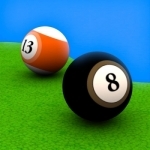
Pool Break 3D Billiards 8 Ball, 9 Ball, Snooker
Games and Lifestyle
App
Pool Break is a suite of games featuring several variations of 3D Pool, Billiards, Snooker, and the...
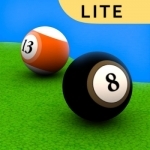
Pool Break Lite 3D Billiards 8 Ball Snooker Carrom
Games and Sports
App
Pool Break Lite is a free suite of games featuring several variations of 3D Pool, Billiards,...
